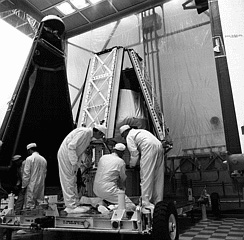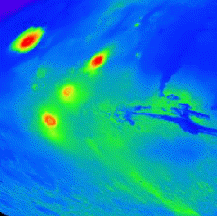This is an image of a Martian storm front.
Image from: NASA
Martian Storm
This is an image of a storm moving across the Martian land. The camera is looking down on the storm, the same way storms are presented on the news.
The storm provides evidence that there is water on Mars.
As early as 1796 scientists thought they saw "yellow", and "white" or "bluish" clouds in the Martian atmosphere. However, it wasn't until the Mariner 9 mission that clouds of water were firmly identified.
More study is needed to understand just how the clouds come and go in the Martian atmosphere. For example, even though clouds can be seen, scientists are not sure whether it actually rains on Mars.
You might also be interested in:

Prior to the Mariner missions, we had to rely on ground-based observations to look at Mars. Using ground-based observations, scientists were able to identify channels, polar caps which varied with season,
...more
This is the first image showing clouds of Mars taken from the lander. Scientists know that the clouds are made of water. And there are weather patterns on Mars which resemble terrestrial storms. It is
...more
On this map of Mars, the lightly cratered Tharsis Ridge is shown, as well as the heavily cratered Martian highlands (near the bottom of the picture), and Valles Marineris to the right. The volcanoes are
...more
On Mars, the water is trapped, frozen, within the ground. Nevertheless, there is evidence for running water on Mars. When the water is melted and released to the surface, it will run from higher ground
...more
The drawing shows the depth at which water may be frozen into the ground. To have water running on the surface of Mars, this water region must be near to the surface. This may have happened at various
...more
Separate from the Martian outflow channels, or the river valleys, are large Martian lakes (600 km, or ~1000 miles across) which once were part of a flood.
...more
This picture shows fog on Mars. More fog has been seen in images returned by Mars Global Surveyor of the south polar region of Mars. Martian fog may have a little bit of acid mixed in with the water drops.
...more
The orbit of Mars is very oval shaped. The orbit is much more oval shaped than the Earth's orbit. This means that the climate of Mars can change drastically between warm and cold.
...more














